How to Play the Banjo with a Metronome by Ross Nickerson
A metronome may be the single most effective tool when practicing banjo, but unfortunately, it seems to be one of the least used. One of the reasons is that it is not as easy as it looks, and students become easily discouraged and annoyed with it. The first thing you need to do is find one you like and that works for you. Don’t buy the cheapest one unless it does the job. I’m sure there are a variety of free ones or apps out there but I for one don’t like the digital bleep bleep and I don’t want to drop my phone fumbling for it with picks on. The metronome should be easy to see, hear, and operate. A headphone jack is a good option. I have a student who bought a more expensive metronome that was loud and easy to use. It was easily the best investment he ever made and its use made a big impact on his progress. You only need to spend enough to get one that you will be drawn too and that works for you. My favorite basic one is The Matrix 800, its loud, sounds like a drumstick hitting wood and is easy to use, pretty unbreakable too.
In my experience the best way to learn to use a metronome is start very simple. This allows you to get on the train at a slow speed and let it all sink in for awhile. Don’t make the mistake of learning the metronome at the same time as the new hard song you are working on. Play exercises that are easy to play by muscle memory and lock in, count with the metronome and feel the beat, before moving to anything more difficult. Be patient and take it one step at a time. Once you understand, the relationship of 1/8 note and 1/4 notes, know where the 4 beat measures start and end and can count time, it will stick with you. Then all you need to do is keep improving at it with practice and all the priority it deserves.
In this measure below there are four 1/4 beats. Set the metronome at 90 beats. one click per 1/4 note. Now, (without playing your banjo) count out loud 1 2 3 4 over and over with the click. Tap your foot at the same time if you want. Do this about 12 times.
Ok, now get your banjo out and play this thumb-pinch thumb-pinch exercise about 20 consecutive times at 90 beats per second, Next switch the speed between 80 beats and 130 beats, still 4 clicks per measure and playing the exercise consecutive times on each new speed. This is super simple but this measure may be one of the most powerful measures Earl Scruggs ever played. It sets the tone and is very rhythmic. There is nothing I love more then ending a solo with an emphatic thumb-pinch thumb-pinch. Give it a try and be sure to lock in before reading the suggestions and moving to the exercises below.
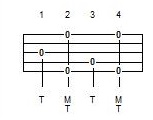
Some Suggestions on Using a Metronome
* Count with the metronome before trying to play along; for example, count out loud the rhythm exercises below before trying to play them.
* While counting out loud, tap out the rhythms with a pencil against the music stand or book, or while tapping your foot.
* The standard way metronome settings are spoken of and listed in books are normally one click or light blink for each 1/4 beat or two 1/8 notes. One you get a little faster, cut time is used. That is two clicks per measure, two 1/4 notes or four 1/8 notes per click.
* A good starting speed to set the metronome in the beginning would be a slow speed of 80 to 110 when using a click for each 1/4 note. Medium speed, from 120 to 150 still using a click for each 1/4 note, and a moderate faster speed, 100 to 110, cut time, cut time defined as two clicks per 1/4 note. or four 1/8 notes per click.
* Do the best you can and be patient! Getting even close to correct with the metronome is likely an improvement, and it really only takes a little time and practice. Working on rhythm and timing is fun.
* Keep in mind that if you feel the metronome is a nuisance and annoying like some of my students have in the past, remind yourself that playing out of time can be extremely difficult to the listener. Truth be told if you play in time, most everyone will like it, they might not even know why. Everyone has a steady heartbeat and even the most causal listener can tell when some one is not playing steady or is off the beat. If people want to clap their hands or tap their foot when they hear you play, you are well on you’re way.
* Learn to play these next exercises well and with the metronome and I flat out guarantee it will help every aspect of your playing, including your overall enjoyment. And remember, these exercises are easy to play so you can focus only on rhythm, timing, attack and listening to yourself. Don’t worry, if you get solid it will translate in to the more difficult songs you play and learn.
Use the same step by step approach with these, count them out loud with the metronome first. The + sign is the up beat. Tap your foot while counting out loud, when your foot goes down its the down beat, when there is an 1/8 note attached between the down beats, that’s the upbeat and the foot comes up. There are always four 1/4 notes in a measure of 4/4 time (4/4 stands for 4 beats to a measure) the only question is how many 1/8 notes or upbeats and where they are placed. A good way to illustrate using the first example is by tapping your foot with the metronome, and saying out loud with the movement of your foot, down down down up down up, or 1 2 3+4+. The foot is coming up on the + sign. I recommend that you count each of them out loud a few times with the metronome, lock it and then get your banjo and try them.

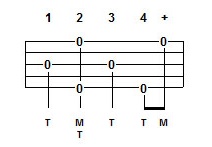
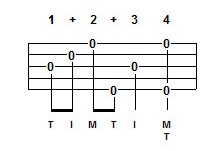
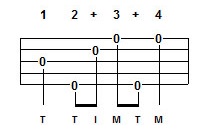
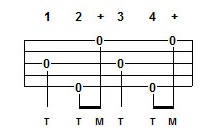

If any if the rolls feel new or awkward, work out the muscle memory at a slow speed so you can really concentrate on the timing. In the third example make sure you use the index finger for the 1/4 note on the 3rd string.
I hope the article was helpful, I appreciate your interest and support!
Thanks, Ross Nickerson
Check out the
The Matrix 800
Other Metronomes
Rock Solid Timing and Backup
The Banjo Encyclopedia, Bluegrass Banjo from A to Z
More instruction and banjo supplies
